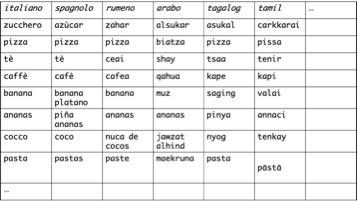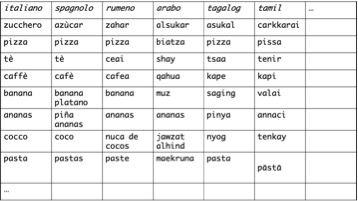Want to borrow a word? (age 8+)
Aim
This activity allows for discussion of the fact that languages can "talk" to each other (through linguistic loans) or be linked to each other for historical reasons (we speak of co-etimological words, that is they have the same linguistic root). The aim is to discover similarities and differences between languages, as well as the intertwining and exchanges between languages (and cultures) that are found in every language.
How to:
The activity focuses on loans in the semantic field of food, but it is possible to focus on other common etymons, for example numbers. In both cases, these are words used everyday that children can easily understand.
Phase 1:
Children can be organized into groups and a table similar to the one shown below can be distributed to each group. Tables can be created through the “table” function in Word or Power Point (or similar programs and / or open source).

The first column, which can be customized by each class, is the same for all groups, while the languages involved change. In each group there must be at least one native speaker of each language on the card. The children must complete the table by writing how to translate the images shown.
The teacher can help the children create a dossier in different languages, similar to the one below (translations must always to be checked: use a tool like google translator in the Beeba platform)

Phase 2:
Once the children have completed their tables, the teacher can guide a comparison of the different words. One at a time, discuss analogies and differences between words and then group them by similarity, trying to highlight how languages can "talk" to each other.
For example, it is possible to introduce the fact that many Arabic words are similar in Spanish and Italian above) preceded by "a" or "al"; this element, in Arabic, corresponds to the article. When the word entered other languages, it brought its own article, probably because the speakers (Spaniards and Italians) did not know that it was similar to ours. It's a bit as if in Italian we said the computer anziché computer.
Sources:
Fusco, Fabiana, Che cos’è l’interlinguistica, Roma, Carocci